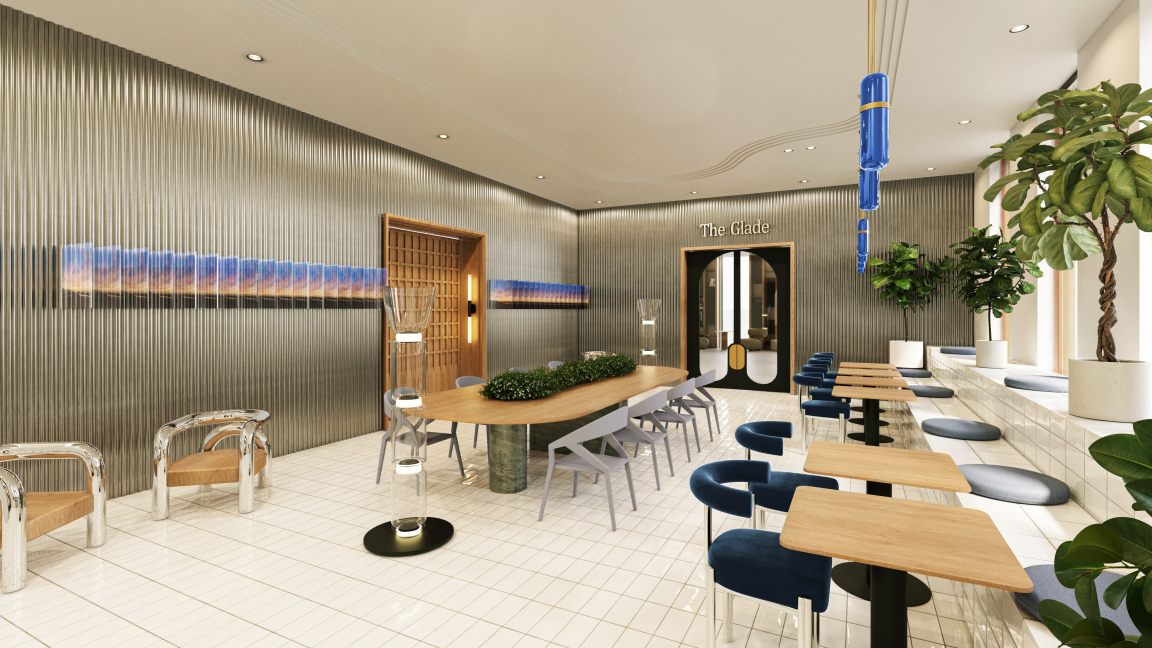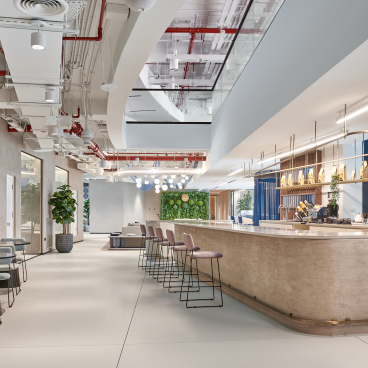Next Generation Conversations: Courteney Kiely, founder & creative director of Scene Interiors.

Courteney Kiely of Scene Interiors talks carving out new apprenticeship pathways for interior design education, widening diversity, and ESG-led interiors.
Courteney is the founder and creative director of Scene Interiors - a full service interior design practice supporting a range of sectors. Taking an ESG-led approach to interior design – with particular emphasis on the 'S' - Scene creates 'boundary shifting interior spaces' truly focused on those that use them.
Keen to cultivate a new generation of diverse talent, and offer alternative avenues into the interiors sector, Courteney is blazing a trail in how the designers of tomorrow get their first break into the industry.
Here we chat to Courteney about setting up Scene Interiors, where she views the current gaps in the industry, and offering the very first Level 6 Interior Design Apprenticeship…
Firstly, could you please introduce us to Scene Interiors?
“We’re a new, ESG-led commercial interior design studio based in Manchester, blending true design originality with positive social impact.
“Our team is a collective of architectural and interior designers from, not just the UK, but across Europe, who bring experience from some of the most design-led markets around the world, supported by a project management team based locally to provide a high-level of client service.
“We focus on some core areas of the market, specifically built to rent, purpose built student accommodation, workspace and hospitality. Our ideal project is one that combines all of the above.
“We’re most active in the North West but have delivered schemes in Birmingham, Leeds and London.”
Scene is described as providing a "fearless design sensibility". Can you talk us through this?
“So much interior design is trend based, where a particular aesthetic is applied to the scheme regardless of the specific building characteristics, user community or social context. Our process is different in that we gather a lot of insight at the start of the design process to inform the concept, then draw from a much wider set of influences to bring it to life. What that creates is something that’s entirely unique to each scheme, rather than the so-called signature look that a lot of studios deliver.”


What was your personal route into interior design? And reflecting back, what was your overall experience of taking this route?
“After college, I started studying architecture at university but felt constrained, I hated the university environment and frankly, couldn’t afford to finish my studies. After dropping out of university, I joined a small interior design firm to gain practical experience and progressed to a senior design role. By the time I was 24, I could already see there was a need for a different kind of approach so decided to set up Scene.
“My early years in employment were mostly on-the-job learning and sink-or-swim situations. That gave me a lot of early exposure but also felt unstructured. I wish there had been an apprenticeship which would help me acquire the skills today’s interior designers need in a more systematic way – technical, design and commercial skills – combined with practical experience and paid employment.
“Up until now, the traditional pathways into the industry for young people have been either university or internship, which closes off a career in interior design to the majority of people who either can’t afford higher education or don’t have the connections. This is something I’m personally keen to tackle through the work we’re doing through Social Scene – hosting career days at schools and colleges to help young people discover interior design, giving more young people access to inspiring design through pro bono schemes with schools and, of course, developing the apprenticeship.”
You have been chairing a trailblazer group to develop a brand-new Level 6 Interior Design Apprenticeship. Can you tell us more about the course and its structure?
“Early last year I approached several credible members of the interior design industry to form a trailblazer group and since then, we’ve worked relentlessly with the Institute for Apprenticeships & Technical Education to define a distinct and comprehensive set of knowledge, skills and behaviours which form the foundation of an interior designer’s role and will be learnt as part of the apprenticeship course.
“The interior design industry is growing due to increased demand as more developers recognise the important role it plays in delivering schemes that are not only functional but sustainable, inspiring, and capable of enhancing the wellbeing of those using the space, and we need to ensure that future generations of interior designers are equipped with the skills to meet the increasingly complex needs of our clients.
“The course will be two years in duration and will see the apprentices build a portfolio of work, develop both design and technical skills and produce their own interior design project which will form part of the course assessment.”



How will this route compare and differ to the university avenue?
“Most importantly, it’s more affordable, as it will offer paid employment alongside structured learning to a recognised standard. That opens it up to a more diverse range of talent and will contribute to making the interior design industry far more inclusive than it currently is.
“But not only that, the consensus from employers and senior members of staff within the industry who I’ve had countless conversations with over the last two years, is that graduates coming out of university are just not equipped with a substantial level of commercial awareness and we want to tackle this through the apprenticeship by ensuring that an apprentice will be exposed to every aspect of an interior designers role.
"From initial client meetings and concept design, right through to building relationships with stakeholders, negotiating with suppliers and being onsite during procurement. And not just the conceptual design elements which university degrees are often so focussed on.”
You say your ambition for the apprenticeship is "to meet the future needs of the industry, whilst creating a more inclusive, diverse and attractive industry for young people". What do you feel is lacking currently in the industry and what are your strategies for improvement?
“If we think about the diversity of communities that are using our spaces, it seems logical that they should be designed by people with a far greater diversity of lived experience. That’s precisely what the apprenticeship aims to deliver – a new generation of diverse talent.
“Also, the industry is evolving quicker than ever and our talent needs to stay ahead. Developers are more and more ambitious with the schemes they’re bringing to market, both from a sustainability and social impact point of view as well as in their design standards. At the same time, there are new methods, materials and manufacturers coming to market. We want to build a talent pool with the knowledge to help developers deliver on their goals.”
You've shared with us the staggering statistic that those from lower socioeconomic backgrounds make up just 12% of the workforce in creative industries, despite representing half of the population. What impact does this have on the creative sectors? And how can change be implemented?
“I think this can create two problems. Firstly, in any industry where creativity is king, the range of influences will be narrower if the design team has a narrow demographic or lived experience. The more diverse the team, the more ideas come to the table, as there are more cultural and social experiences being brought to bear, which can create a far more truly original outcome.
“Secondly, I think a lot of design can feel alienating for the very people using the space. We see a lot of schemes which have simply applied the aesthetics of luxury interior design regardless of the building, its users or its context. But when you have a design team which identifies with a target audience, you’re able to reflect their needs more fully.


Applications for the Level 6 apprenticeship are expected to start imminently. What is your advice for those putting together their portfolios for consideration?
“Don’t worry about portfolios! It’s about showing a true understanding of the course and its content, and a true passion for building a professional career in interior design. There are so many resources available online – from the British Institute of Interior Design to magazines to influencers. Read around the subject and be familiar with the themes interior design needs to tackle.
“There are also countless inspiring examples of interior design that you can visit, either online or in person. Immerse yourself and make note of how the space made you feel, what works well and what doesn’t.
And, what are your tips for those preparing for the interview process?
“My number one tip for anything is be yourself and if things don’t go to plan then keep trying!”
As founder and creative director of your own practice, can you share with us some golden nuggets of advice for those embarking on setting up their own business?
“The best advice I can give is to find your space in the market – asking yourself the question, 'how can I make what I’m offering different?' That starts with understanding how client needs are evolving and what your competitors are doing, then looking for gaps. For me, that was a more ESG-led approach to interior design – with particular emphasis on the 'S' - and far greater design originality.
“Also, take your proposition into the market and get feedback. The property community is one of the most supportive industries. I’ve been lucky to spend time with some incredibly successful and insightful people who’ve given me invaluable feedback, which I’ve applied. And remember it’s never a completed process. No business should ever look the same year to year – keep looking ahead and keep evolving.
“Finally, stop talking about it and just do it!”
Lastly, what are you excited to see from the designers of tomorrow through the L6 Interior Design Apprenticeship?
“A much wider diversity of talent, bringing forward ground-breaking schemes that surpass anything the industry has seen so far with their social impact, sustainability and originality.”




